Are you a Quiet Speculation member?
If not, now is a perfect time to join up! Our powerful tools, breaking-news analysis, and exclusive Discord channel will make sure you stay up to date and ahead of the curve.
The decision to sell a piece of Power can be difficult, and should not be taken lightly. I remember back before I got into Vintage, I flipped a few pieces of Power in my day. Most of this was arbitrage—I would purchase a few heavily played copies from a European seller to sell in the U.S. for a slight markup (my margins were always razor thin).
Back in 2015, I made the decision to actually collect a set of Power Nine (under @MissouriMTG’s tutelage). Since then, I never even considered the prospect of selling a piece of Power.
Until 2021.
What changed after six years? Firstly, I picked up a couple Collectors’ Edition copies of Power through trade with ABUGames; I didn’t really intend to keep those over the long term. I considered the non-tournament legal cards exceptions to my self-imposed rule. It didn’t feel so bad selling those, especially if I could help out a couple Old School players obtain copies they could feel comfortable shuffling up in a game. I rationalized the decision to sell, convincing myself it would be my Unlimited Power that I would hold for years and years.
Another Exception to the Rule
Last week I began pondering yet another exception to my rule. I currently own a spare Unlimited Mox Sapphire.
I picked up this heavily played copy after making a few consecutive sales a while back (before the most recent jump in price). I had intended to add the card to one of my Old School decks, but I never followed up. Instead, the card sits in my binder in all its glory.
When I made a passing comment in the Quiet Speculation Discord about pondering a sale, a friend of mine contacted me through Discord and asked me about a price.
That’s where I faltered.
I struggled to come up with a definitive price—one that would be fair relative to its market value, but also modestly discounted in acknowledgement of our friendship. But even putting the friendship factor aside for a second, how many people (who aren’t vendors / don’t work for vendors) could accurately declare the value of a heavily played Mox Sapphire? I check on Card Kingdom’s buylist for Power now and again, but that doesn’t exactly reflect true market value.
My first stop was eBay—looking at eBay completed listings, I figured I’d get a good feel for what the card has been selling for recently.
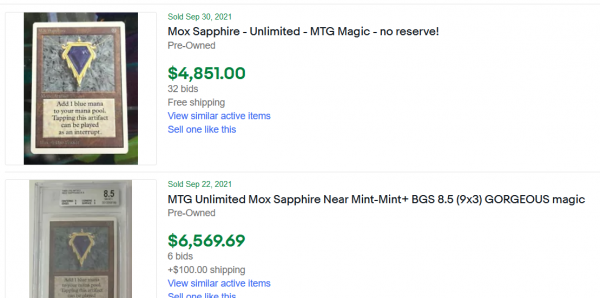
This exercise was moderately helpful. While a couple of the numbers seemed consistent, such as the two completed listings above, other values were useless at best and suspect at worst. Consider these two completed listings (note there were only 8, so these two represent 25% of them).
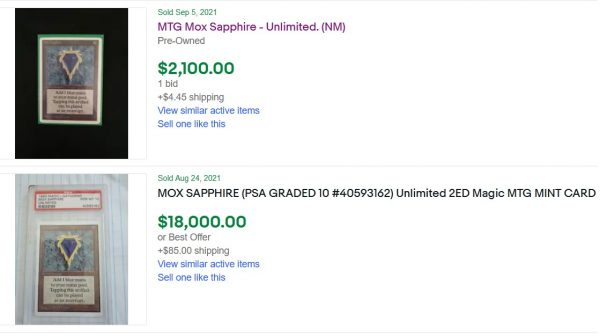
The top listing is extremely suspicious. Who would sell a near mint Mox Sapphire for $2100 in 2021? The seller had some feedback, but I still wouldn’t trust this data point. The bottom listing is probably perfectly reflective of the market…the market for PSA 10 copies, that is! Seeing this copy sell for $18,000 doesn’t really help me price my heavily played copy much.
Still, I can guesstimate that a heavily played copy should sell for somewhere in the high $3,000’s range based on the complete data set.
Recently, TCGplayer started sharing recent sales to all shoppers—not just those with a seller account. Checking there, I see a single data point: an LP copy sold back in August for $5899.99. Not all that helpful, but consistent with eBay for the most part. The lowest price for a heavily played copy on TCGplayer is about $4100. Knocking off 10% for fees, you end up in the $3600-$3700 range.
It’s worth noting, however, that the heavily played copy listed is in considerably worse condition than my own. But in terms of identifying a ballpark number to work with, it seems like anywhere between $3600 and $3900 would be fairly priced, with some wiggle room within the range.
A Surprising Side Note
The purpose for this week’s article is twofold. First, I wanted to share a brief overview of how one could go about pricing a high-end piece of cardboard, highlighting the pitfalls of outlier data. But my research inspired a second, tangential topic related to Power.
While researching Card Kingdom’s prices for Unlimited Power, I discovered a trend I hadn’t seen before:
As of right now, Card Kingdom sells Mox Jet for a higher price than Mox Sapphire! The blue Mox has been dethroned as the most valuable color, at least according to Card Kingdom. I’m not sure if that has ever happened in the history of the game. Sapphire used to be the second most valuable piece of Power, after Black Lotus. Now, at least according to Card Kingdom, it’s number four (also behind Timetwister.
For the record, there are cheaper damaged and heavily played copies of Mox Jet than there are of Mox Sapphire on TCGplayer. Though it’s worth noting that the last sold LP copy of Mox Jet apparently went for $7,175. I’m not sure I fully embrace that data point as an indication of the card’s value relative to Sapphire, but the directional trend is consistent with Card Kingdom.
Either way, it’s safe to say the two are valued closer together than in the past.
A Brief History Lesson
Now for the fun part of the article. When I saw this trend on Card Kingdom’s website, I decided to do a quick check through some historical data to see if Mox Sapphire was ever worth the same as Mox Jet. According to InQuest Magazine, this was the case…back in 1995! Here’s a comparison of prices for the Power Nine between InQuest’s first issue from May 1995 and their final (150th) issue from October 2007.
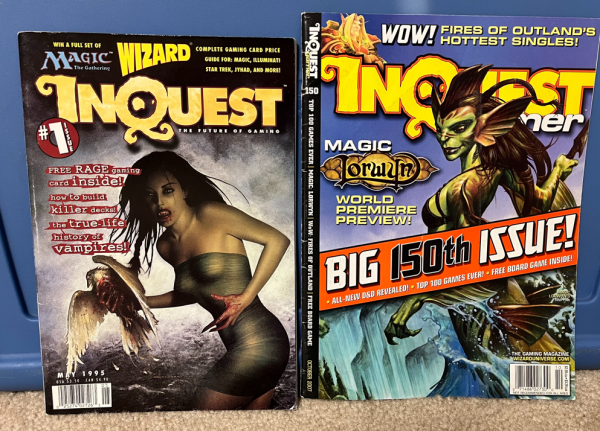
Warning: Be prepared to be depressed at how “cheap” these used to be!
Card | Value in InQuest #1 | Value in InQuest #150
Black Lotus | $150 | $800
Timetwister | $52.50 | $200
Mox Sapphire | $80 | $450
Mox Jet | $80 | $400
Mox Ruby | $80 | $350
Mox Emerald | $80 | $350
Mox Pearl | $80 | $350
Ancestral Recall | $60 | $500
Time Walk | $75 | $400
Back in the early days of Magic, the five Moxes were all considered relatively equivalent in value. However as the years progressed, it became clear that Blue was the best color in Magic, creating separation between Mox Sapphire, Time Walk, and Ancestral Recall and the non-blue Moxes. Note that even as late as 2007, you could still find beat copies of Timetwister for $125-$150 (in fact I once purchased an HP copy on eBay for $125 around 2009).
Of course, thanks to its legality in Commander, Timetwister has soared to new heights becoming the second most valuable piece of Power. Nowadays it’s not even close. In fact, Card Kingdom has a VG copy in stock so it makes for an easy price comparison. VG Timetwister: $7799.99. VG Mox Jet (third most valuable): $5399.99. That’s a delta of $2400!
It’s also interesting to see how Ancestral Recall and Time Walk have dropped in relative price since 2007. Back then, these two blue cards were worth more than the non-blue Moxes. Nowadays, according to Card Kingdom, Ancestral Recall lags behind Mox Jet (but still ahead of Emerald, Ruby, and Pearl) and Time Walk is only ahead of Ruby and Pearl.
Apparently, Mox Emerald has also shown a slight bump in popularity relative to Ruby and Pearl. And Mox Pearl is in a distant last, with near mint copies listed at $800 less than the next cheapest piece of Power, Mox Ruby.
Wrapping It Up
If I had the time, I would look at all the InQuest magazine issues in between 1 and 150 to track the evolution of Power Nine pricing. But that’s not something I can prioritize at the moment, so for now we’ll have to settle for the first and last. (Side note: if anyone wants to embark on a long endeavor, it would be amazing to digitize InQuest Magazine’s pricing data over the years of its existence…I think some folks would pay for access to that!).
Luckily, the two issues of InQuest are spaced far enough apart that we can get a great snapshot of how Power pricing has evolved over the years. We have a data point from 1995, a data point from 2007, and of course a data point from 2021. Over the years, we can see how the five Moxes started to differentiate from one another. At first, only Mox Sapphire outpaced the rest. Then, over the last decade, we’ve seen all five Moxes become slightly different in price from one another.
And, most recently, Mox Jet has demonstrated competition with Mox Sapphire to become the most valuable Mox. I’m not exactly sure what catalyzed this change—likely it’s part of Card Kingdom’s pricing algorithm. But even if that’s all it is, that’s still a reflection of actual sales data from Card Kingdom, so I don’t take the data point lightly. This could be a real trend, and it’ll be interesting to see if it continues over the next decade.
As for my Mox Sapphire for sale, I now have a good idea what my asking price should be. At this point, it really comes down to my motivation (or lack thereof) to take quality pictures of the card and post it for sale somewhere. I’m not eager to sell the card; as I said at the beginning, I don’t like selling my Power. I’ll have to let it go eventually, since my end goal is still to fund my kids’ college costs with Magic. I just don’t need to rush out today and sell it.
I’ll get to it eventually. I have time.


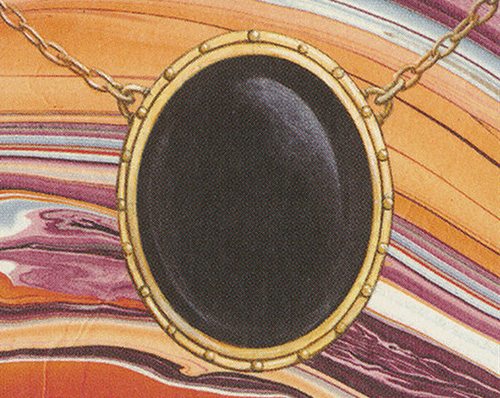
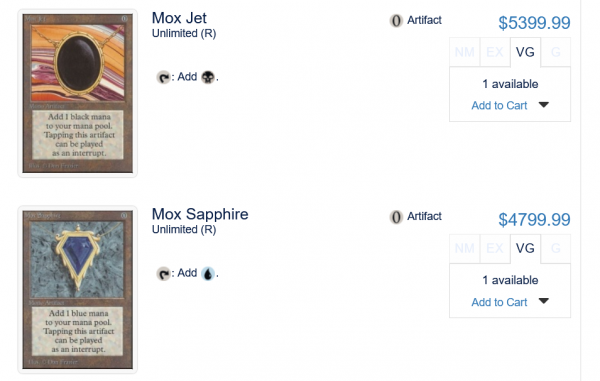



I remember a highly graded Unlimited Black Lotus selling for $1,500 at ABUGames back in 2012. I passed on it back then because I was more focused in collecting Alpha. I ended up with a near mint Mox Emerald from Alpha instead, so I made up for it. But still I regret not jumping at it when I had the chance. ABUGames still keeps a record of all those transactions. That would definitely be worth looking at.